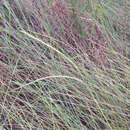Comprehensive Description
provided by North American Flora
Paspalum monostachyum Vasey; Chapm. Fl. S. U. S
ed. 2. 665. 1883.
Paspalum rectum longispicatum. Vasey, Bot. Gaz. 9 : 54. 1884. Paspalum solitarium Nash, in Small, Fl. SU. U. S. 77. 1903.
A tall perennial with long and stout scaly rootstocks, the scales glabrous, stout stolons, erect rigid stems, and glabrous spikelets. Stems single, rigid, 6-12 dm. tall, sometimes shorter; leaf -sheaths glabrous, or sometimes pubescent on the margin; blades elongate, the larger ones often 3-6 dm. long, longacuminate, rigid, involute, at least when dry, glabrous; racemes single, or rarely in 2's, 1-2 dm. long, the rachis roimded on the back, less than 1 mm. wide; spikelets crowded, 3 mm. long and about 1.5 mm. wide, in pairs on hispid pedicels, elliptic, the first scale wanting, the second and third scales 3-nerved, the fruiting scale yellowish, smooth.
Type locality : Southern Florida. Distribution: Southern Florida and Texas.
- bibliographic citation
- George Valentine Nash. 1912. (POALES); POACEAE (pars). North American flora. vol 17(2). New York Botanical Garden, New York, NY
Physical Description
provided by USDA PLANTS text
Perennials, Terrestrial, not aquatic, Rhizomes present, Rhizome elongate, creeping, stems distant, Stems nodes swollen or brittle, Stems erect or ascending, Stems solitary, Stems terete, round in cross section, or polygonal, Stem internodes solid or spongy, Stem internodes hollow, Stems with inflorescence less than 1 m tall, Stems with inflorescence 1-2 m tall, Stems, culms, or scapes exceeding basal leaves, Leaves mostly cauline, Leaves conspicuously 2-ranked, distichous, Leaves sheathing at base, Leaf sheath mostly open, or loose, Leaf sheath smooth, glabrous, Leaf sheath and blade differentiated, Leaf blades linear, Leaf blades very narrow or filiform, less than 2 mm wide, Leaf blades 2-10 mm wide, Leaf blade margins folded, involute, or conduplicate, Leaf blades mostly glabrous, Leaf blades scabrous, roughened, or wrinkled, Ligule present, Ligule a fringed, ciliate, or lobed membrane, Inflorescence terminal, Inflorescence solitary, with 1 spike, fascicle, glomerule, head, or cluster per stem or culm, Inflorescence a panicle with narrowly racemose or spicate branches, Inflorescence single raceme, fascicle or spike, Inflorescence with 2-10 branches, Inflorescence branches more than 10 to numerous, Inflorescence branches 1-sided, Inflorescence branches paired or digitate at a single node, Inflorescence branches paired racemes, V-shaped, Rachis dilated, flat, central axis to which spikelets are attached, Flowers bisexual, Spikelets pedicella te, Spikelets sessile or subsessile, Spikelets dorsally compressed or terete, Spikelet less than 3 mm wide, Spikelets with 1 fertile floret, Spikelets with 2 florets, Spikelet with 1 fertile floret and 1-2 sterile florets, Spikelets paired at rachis nodes, Spikelets all alike and fertille, Spikelets bisexual, Spikelets disarticulating below the glumes, Spikelets secund, in rows on one side of rachis, Rachilla or pedicel glabrous, Glumes present, empty bracts, Glumes 2 clearly present, Glumes distinctly unequal, Glumes equal to or longer than adjacent lemma, Glume equal to or longer than spikelet, Glumes 3 nerved, Lemma similar in texture to glumes, Lemma 3 nerved, Lemma glabrous, Lemma apex truncate, rounded, or obtuse, Lemma awnless, Lemma straight, Palea present, well developed, Palea shorter than lemma, Stamens 3, Styles 2-fid, deeply 2-branched, Stigmas 2, Fruit - caryopsis.

